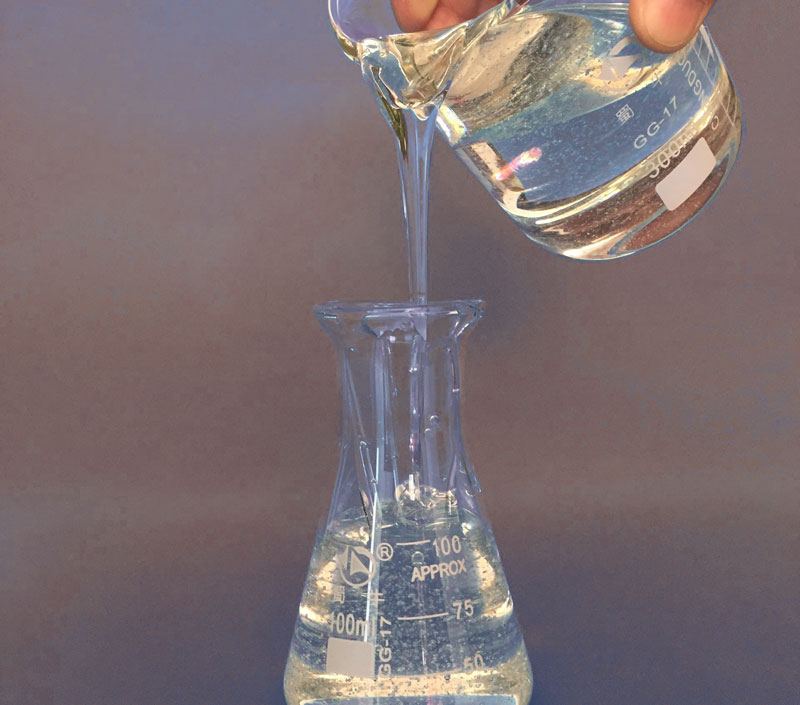Previous:what is acrylic resin and how classification?
(2) Classified by form
①Solid acrylic resin
Solid acrylic resins are mainly thermoplastic acrylic resins, including some thermosetting acrylic resins, which have good mechanical properties (such as good tensile and bending properties) and optical properties at room temperature. The softening temperature of different types of solid acrylic resins varies greatly, and optical products of various shapes and types are mainly produced by thermal processing.
②Liquid acrylic resin
a, water-soluble acrylic resin
The main chain or side chain of the water-soluble acrylic resin contains enough polar groups or ionic groups,
So it can be dissolved in water, mainly including poly(meth)acrylic acid, poly(meth)acrylamide and some N-substituted poly(meth)acrylamide, poly(meth)acrylate and so on. Water-soluble acrylic resin can be synthesized by solution polymerization, emulsion polymerization, inverse emulsion polymerization and graft polymerization; some hydrophilic acrylic monomers can also be used or contain sufficient amount (for example, 50% or more). A mixture of acrylic monomers and acrylates and other monomers, using water as a solvent
Perform polymerization to make an aqueous solution of acrylic resin.
Water-soluble acrylic resins can be used as thickeners, automotive coatings, inks, fabric treatment agents, emulsifiers, dispersants, scale inhibitors, flocculants, thickeners, soil conditioners, water quality stabilizers, water-soluble adhesives , Cosmetic additives, etc., in textiles,
It is widely used in the fields of medicine, mineral processing, petroleum, environmental protection, food, papermaking, water treatment, agriculture and forestry.
The water-soluble acrylic resin has low curing temperature, short time and simple construction; it has viscosity increasing, conductivity and ion exchange; it is easy to modify, and can be modified by adding various additives to make products with different properties and categories; made The membrane is acid and alkali resistant,
Strong oil ability; adjustable apparent color, good gloss, good adhesion, strong scratch resistance and high light transmittance.
b. Acrylic resin emulsion
Acrylic resin emulsion is usually prepared by emulsion copolymerization of acrylic ester monomers (such as acrylic acid butadiene, acrylonitrile, acrylamide or their mixtures). The emulsion is sapphire or blue-white, with a solid content of 20%-40%. It can be used as leather finishing. Film-forming agent and adhesive in the agent,
It has the advantages of bright film formation, flexibility, water resistance, and strong adhesion. According to the different proportions of various acrylate monomers used,
The film-forming properties of the obtained copolymers are divided into soft, medium-hard and hard, and are used in the fields of coatings, paints, inks, adhesives, rubbers, chromatographic column fillers, electron microscope standards and drug slow-release carriers.
Acrylic resin emulsion has good weather resistance and heat resistance; excellent mechanical properties, high hardness, good abrasion resistance; short surface drying and hard drying time, convenient construction; good adhesion to metal, plastic and other substrates; Transparent, bright, full color; flexible modification, adjustable viscosity, various polymerization methods.

(3) Classified by reaction type
①Reaction cross-linked acrylic resin
Reactive crosslinking acrylic resin means that the functional groups in the prepolymer have no self-crosslinking ability, and crosslinking components with at least 2 functional groups must be added (such as melamine resin, epoxy resin, urea resin, metal oxide, etc.) Acrylic resins that are cross-linked and cured by reaction, such as copolymerization of butyl acrylate, styrene, a methacrylic acid and 2-hydroxyethyl acrylate, can be used in
Catalyzed by metal cations such as potassium ions and calcium ions, it is cross-linked with water-based epoxy resin and spread on a single crystal silicon substrate to form a copolymer ultra-thin film with better comprehensive performance.
②Self-crosslinking acrylic resin
Self-crosslinking acrylic resin means that the prepolymer chain itself contains two or more reactive functional groups (hydroxyl, carboxyl, amido, hydroxymethyl, etc.). When heated to a certain temperature or a catalyst is added, the functional groups can interact with each other. Reaction, self-crosslinking. The self-crosslinked acrylic resin can significantly improve its water resistance and solvent resistance, as well as its mechanical strength and heat resistance. Acrylic monomers and two monomers containing different functional groups (such as hydroxyl, carboxyl and amino, etc.) or one
A solution polymer or emulsion polymer obtained by copolymerization of monomers containing two types of functional groups (such as methylol acrylamide, containing hydroxyl and amino groups). The two types of functional groups on the polymer chain can also react with each other during film formation to achieve self-interaction. Linked multivalent metals are also commonly used self-crosslinking agents. Self-crosslinking acrylic resins are mainly used as fabric, leather, paper treatment agents and coatings.
(4) Classified by purpose
There are many kinds of monomers for the preparation of acrylic resins, various polymerization processes, and various uses. They are ubiquitous in production and human daily life. The application and characteristics of acrylic resins will be introduced in detail in Chapter